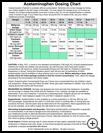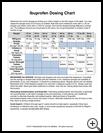
Medicines for Fever or Pain Relief
Acetaminophen
Acetaminophen (Tylenol) is available without a prescription. Determine the correct dosage by finding your child's weight on the left margin of the table. You may repeat the dosage every 4 to 6 hours as needed. Do not give acetaminophen more than 5 times a day. Do not use acetaminophen in children under 3 months of age. If your infant has a fever during the first 12 weeks of life, see your child's healthcare provider immediately.
Weight (Dosage Form) Dose
----------------------------------------------------------------
6-11 pounds infant drops 0.4 ml or 40 mg
children's liquid 1.25 ml
----------------------------------------------------------------
12-17 pounds infant drops 0.8 ml or 80 mg
children's liquid 2.5 ml
----------------------------------------------------------------
18-23 pounds infant drops 1.2 ml or 120 mg
children's liquid 3.75 ml
chewable 80 mg tablets 1+1/2 tablets or 120 mg
----------------------------------------------------------------
24-35 pounds infant drops 1.6 ml or 160 mg
children's liquid 5 ml
chewable tablets 2 tablets or 160 mg
Jr. strength tablets 1 tablet or 160 mg
----------------------------------------------------------------
36-55 pounds infant drops 2.4 ml or 240 mg
children's liquid 7.5 ml
chewable tablets 3 tablets or 240 mg
Jr. strength tablets 1+1/2 tablet or 240 mg
----------------------------------------------------------------
56-83 pounds chewable tablets 4 tablets or 320 mg
Jr. strength tablets 2 tablets or 320 mg
adult tablets 1 tablet or 325 mg
----------------------------------------------------------------
84-111 pounds chewable tablets 6 tablets or 480 mg
Jr. strength tablets 3 tablets or 480 mg
adult 325 mg tablets 1+1/2 tablets or 480 mg
----------------------------------------------------------------
112+ pounds chewable tablets 8 tablets or 640 mg
Jr. strength tablets 4 tablets or 640 mg
adult tablets 2 tablets or 650 mg
----------------------------------------------------------------
Abbreviations: mg = milligrams ml = milliliter
CAUTION: In May, 2011, a move to one standard concentration (160 mg/5 ml) of liquid acetaminophen medicine for infants and children was announced. Up until this point, there have been mainly 2 concentrations: 80 mg/0.8 ml (Infant Concentrated Drops) and 160 mg/5 ml (Children's Liquid Oral Suspension or Syrup). During this transition period, both old and new concentrations of infant acetaminophen may be available on store shelves and in your home. Before selecting a dose, please double check the infant package carefully to find the correct concentration. Then, select the dosage according to the concentration and child's weight.
- Infants’ Acetaminophen Concentrated Drops are 3 times more concentrated than the children’s liquid oral suspension.
- Always read and follow the label.
- Never give adult medicines to children.
- Use only the dosing device that comes with the product.
MEASURING the DOSAGE: Syringes and droppers are more accurate than teaspoons. If possible, use the syringe or dropper that comes with the medicine. If not, medicine syringes are available at pharmacies. If you use a teaspoon, it should be a measuring spoon. Regular spoons are not reliable. Remember that 1 level teaspoon equals 5 ml and that 1/2 teaspoon equals 2.5 ml.
Suppositories: Acetaminophen is also available as a rectal suppository in 120-mg, 325-mg, and 650-mg dosages. Suppositories are useful if a child with a fever is vomiting often or having seizures caused by the fever. Use the same dose as listed above for the suppository. Most suppositories can be cut (for example, cut in half) to supply the right dose for your child's weight.
Ibuprofen
Determine the correct dosage by finding your child's weight on the left margin of the table. You may repeat the dosage every 6 to 8 hours as needed. Note that some medicines come with a 1.25 ml dropper and others come with a 1.875 ml syringe. Don't let the dropper/syringe difference confuse you. The milligram amount you should give is the same. Do not give ibuprofen to children under 6 months of age.
Weight (Dosage Form) Dose
--------------------------------------------------------------------
12-17 pounds drops 1.25 ml or 50 mg
children's liquid 1/2 tsp or 2.5 ml
--------------------------------------------------------------------
18-23 pounds drops 1.875 ml or 75 mg
children's liquid 3/4 tsp or 3.75 ml
--------------------------------------------------------------------
24-35 pounds drops 2.5 ml or 100 mg
children's liquid 1 tsp or 5 ml
chewable tablets 2 tablets or 100 mg
--------------------------------------------------------------------
36-47 pounds drops 3.75 ml or 150 mg
children's liquid 1+1/2 tsp or 7.5 ml
chewable tablets 3 tablets or 150 mg
--------------------------------------------------------------------
48-59 pounds children's liquid 2 tsp or 10 ml
chewable tablets 4 tablets or 200 mg
Jr. strength tablets 2 tablets or 200 mg
--------------------------------------------------------------------
60-71 pounds children's liquid 2+1/2 tsp or 12.5 ml
chewable tablets 5 tablets or 250 mg
Jr. strength tablets 2+1/2 tablets or 250 mg
adult tablets 1 tablet or 200 mg
--------------------------------------------------------------------
72-95 pounds children's liquid 3 tsp or 15 ml
chewable tablets 6 tablets or 300 mg
Jr. strength tablets 3 tablets or 300 mg
adult tablets 1+1/2 tablets or 300 mg
--------------------------------------------------------------------
96+ pounds children's liquid 4 tsp or 20 ml
chewable tablets 8 tablets or 400 mg
Jr. strength tablets 4 tablets or 400 mg
adult tablets 2 tablets or 400 mg
---------------------------------------------------------------------
Abbreviations: mg = milligrams ml = milliliter tsp = teaspoon
Alternating Acetaminophen and Ibuprofen
Alternating acetaminophen and ibuprofen is generally not recommended. It can be confusing and lead to dosage errors and poisoning. In addition, fevers can almost always be brought down to a comfortable level with just one medicine. If instructed by your healthcare provider to alternate ibuprofen and acetaminophen, however, do it as follows:
- Alternate doses of ibuprofen and acetaminophen every 4 hours (not every 3 hours).
- Alternate medicines for only 24 hours or less, then return to giving a single product.
Avoid Aspirin
Children (through age 21 years) should not take aspirin, especially if they have chickenpox or influenza (any cold, cough, or sore throat symptoms). This recommendation is based on several studies that have linked aspirin to Reye's syndrome, a severe encephalitis-like illness. Most pediatricians have stopped using aspirin for all fevers associated with any illness.
Last modified: 2012-02-01
Last reviewed: 2011-09-13


